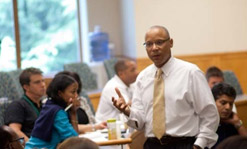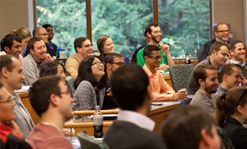Higher Ed Chatter Summit: Creating a Social Enterprise
Topics: Customer Process Management Social
 Colleges and universities are embracing the social tools and customer-relationship management systems once confined to business. The technology can help schools cultivate stronger connections with current and prospective students, faculty, staff, alumni and corporate partners and reducing dependence on linear communications like email. The task of nudging campus culture toward becoming a social enterprise can appear daunting. Questions emerge on how schools can best scope, implement and leverage social CRMs. This day-long summit dove into these considerations by tapping experts who are developing best-practices and innovative applications.
Colleges and universities are embracing the social tools and customer-relationship management systems once confined to business. The technology can help schools cultivate stronger connections with current and prospective students, faculty, staff, alumni and corporate partners and reducing dependence on linear communications like email. The task of nudging campus culture toward becoming a social enterprise can appear daunting. Questions emerge on how schools can best scope, implement and leverage social CRMs. This day-long summit dove into these considerations by tapping experts who are developing best-practices and innovative applications.
.jpg) Join the discussion on Twitter with hashtag #TuckChat
Join the discussion on Twitter with hashtag #TuckChat
Session I
Social Enterprise.edu: Getting High Marks with CRM
9:30 a.m. – 11:30 a.m.
Schools that integrate CRM into their customer‐facing operations are better positioned to improve relationships and reduce the cost of marketing and delivering service. This discussion examined ways in which schools are using CRM tools – Admissions, Executive Education, Development, and Career Services – and how the tools are changing the operational landscape as well as the nature of customer interaction.
Panelists:
John Jibilian, Associate CIO, Yale University
Jeff Shy, President, Affinaquest
Peter C. Young, CIO & VP, Information Technology, University of Maryland University College
Moderator: Kendall Collins, SVP & GM, Chatter at Salesforce.com


Session II KEYNOTE
The Collaboration Culture
Kendall Collins, SVP & GM, Chatter at Salesforce.com
CRM tools are reshaping enterprises to give individuals new ways to interact with customers and colleagues. This technology is powerful not only because it provides simpler ways to communicate but because it flattens hierarchy. The worker lacking in title but rich in ideas can speak directly to the CEO. For the first time, this makes truly social enterprises possible. The questions now become: “What is a social enterprise?” and “What does it mean for our lives at work?” Kendall addressed these topics and fielded questions from the audience.
Kendall Collins, SVP and GM of Salesforce Chatter, is responsible for the product and market strategy for Salesforce Chatter, the enterprise social network and collaboration platform. In his previous role as global CMO forsalesforce.com, Kendall led a transformation of corporate marketing by harnessing the power of the social graph through Chatter. Now, as the GM of Chatter, Kendall is focused on helping other companies transform into social enterprises. Kendall has been driving enterprise and cloud computing strategies for more than 15 years, having led teams at Siebel Systems, Oracle Corporation, A.T. Kearney, and Procter & Gamble in various management positions. He has a degree in Finance and Asian Studies from the University of Virginia.
Kendall can be found on LinkedIn and on Twitter @kendallcollins.
Session III
Email Killer? Taking Chatter at Tuck from Launch to Widespread Adoption in 6 Months
Stephen Pidgeon T’07, Tuck Career Development Office
Eric Markus T’12, Tuck Student Board
Presentation and discussion on how Tuck planned and drove the launch, and subsequent adoption, of Chatter – first as a tool for career development discussions, then as the forum of choice for all student clubs, and now as the primary discussion forum across the school.
Session IV
Learning from Tuck’s Social Experiment: Firsthand Impressions from Users and Developers
Moderator: Stephen Pidgeon T’07, Tuck Career Development Office
Curious about whether Chatter or an equivalent cloud-based community would work for your department or school? Hear from current users (Tuck students) and developers (Salesforce Chatter) on strengths and potential improvements of Tuck’s current implementation. This interactive session was a three-way discussion between users, developer and potential users.







